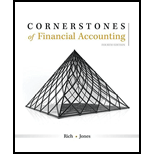
Concept explainers
Concept Introduction:
Operating cycle:
Operating cycle is the chain of business activities performed in an organization. An organization can be manufacturing, servicing of merchandising type. For a merchandiser, the main business activities are the purchase, payment to the supplier, sales, and receipts from the customer. Hence the operating cycle of a merchandiser is limited as compared with the operating cycle of a manufacturer.
The Operating cycle mainly includes following activities:
-Purchases from the supplier (either cash or on account)
-Payment to suppliers
-Inventory
-Sales (either cash or on account)
-Collection from customer
The formula to calculate the operating cycle is as follows:
Net Operating Cycle = Inventory Period +
To Indicate:
Any other reason for the difference in the prices of given stores.
Want to see the full answer?
Check out a sample textbook solution
Chapter 4 Solutions
Cornerstones of Financial Accounting
- Please give me answer accountingarrow_forwardWhat would be the average fixed inspectionarrow_forwardAmber Corp. bought $380,000 worth of furniture on July 15, 2014. On November 20, 2014, the company purchased $140,000 of used office equipment. If Amber Corp. Elects Section 179, what is the maximum write-off for these purchases in 2014?arrow_forward
- No AI please otherwise unhearrow_forwardWhat is the manufacturing overhead of this general accounting question?arrow_forwardQuine Inc. reported sales of $8,500,000 for the month and incurred variable expenses totaling $6,300,000 and fixed expenses totaling $1,500,000. The company has no beginning or ending inventories. A total of 90,000 units were produced and sold last month. How many units would the company have to sell to achieve a desired profit of $1,200,000? (rounding up to the nearest whole unit)arrow_forward
 Cornerstones of Financial AccountingAccountingISBN:9781337690881Author:Jay Rich, Jeff JonesPublisher:Cengage Learning
Cornerstones of Financial AccountingAccountingISBN:9781337690881Author:Jay Rich, Jeff JonesPublisher:Cengage Learning Financial Accounting: The Impact on Decision Make...AccountingISBN:9781305654174Author:Gary A. Porter, Curtis L. NortonPublisher:Cengage LearningPrinciples of Accounting Volume 1AccountingISBN:9781947172685Author:OpenStaxPublisher:OpenStax College
Financial Accounting: The Impact on Decision Make...AccountingISBN:9781305654174Author:Gary A. Porter, Curtis L. NortonPublisher:Cengage LearningPrinciples of Accounting Volume 1AccountingISBN:9781947172685Author:OpenStaxPublisher:OpenStax College Financial And Managerial AccountingAccountingISBN:9781337902663Author:WARREN, Carl S.Publisher:Cengage Learning,
Financial And Managerial AccountingAccountingISBN:9781337902663Author:WARREN, Carl S.Publisher:Cengage Learning,




